 <
<
4.26, 2016
Day:31
Location:Outside of Shimizu Port
Weather:Cloudy
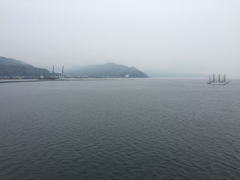 Today's daily science and operations report is the final one for IODP Exp 365. Yesterday was spent in cleaning, report finalizing, and packing. This morning at 08:00 h Chikyu stood by the harbor entrance of Shimizu, and waited on the pilot.
Today's daily science and operations report is the final one for IODP Exp 365. Yesterday was spent in cleaning, report finalizing, and packing. This morning at 08:00 h Chikyu stood by the harbor entrance of Shimizu, and waited on the pilot. Chikyu tied up quayside by 10:00 h, and the scientists will presently disembark. The expedition will officially end mid night tonight (27 April 2016), but we will be back for the shore-based sampling party later this summer.
Photo of the Day:
View from the Shimizu port

4.25, 2016
Day:30
Location:100 nmi of Site C0010; underwater TV test site.
Weather:Overcast
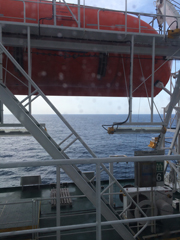 Cored final C0010E cores, and then began POOH RCB BHA and then rig down guide horn. ROV checked LTBMS sensors and also visited Hole C0010D for visual inspection of sea floor.
Cored final C0010E cores, and then began POOH RCB BHA and then rig down guide horn. ROV checked LTBMS sensors and also visited Hole C0010D for visual inspection of sea floor.All expedition science targets and contingency science successfully achieved. Report writing.
Photo of the Day:
Calm seas after the storm of work on coring and science report writing.

4.24, 2016
Day:29
Location:Hole C0010E.
Weather:Partly cloudy
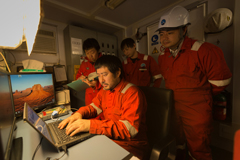 Cored final C0010E cores, and then began POOH RCB BHA and then rig down guide horn. ROV checked LTBMS sensors and also visited Hole C0010D for visual inspection of sea floor.
Cored final C0010E cores, and then began POOH RCB BHA and then rig down guide horn. ROV checked LTBMS sensors and also visited Hole C0010D for visual inspection of sea floor.Completed coring at Hole C0010E; whole round IW and MBIO samples were collected, XCT and MSCL-W scans complete. Scientists working on completing Hole C0010D text and compiling E results from whole round scans. All expedition science targets and contingency science successfully achieved.
Photo of the Day:
Scientists and Drilling Engineer checking the sensors downhole C0010A via ROV hook-up, as the last sea floor science operations during IODP Exp. 365.

4.23, 2016
Day:28
Location:Hole C0010E.
Weather:Rain
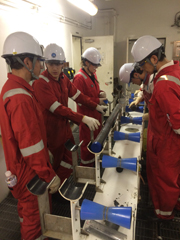 Spudded into Hole C0010E early on Saturday morning. Jetting/drilled ahead to first planned coring depth (360 mbsf). The first core from Hole C0010E arrived on deck at 23:16 h.
Spudded into Hole C0010E early on Saturday morning. Jetting/drilled ahead to first planned coring depth (360 mbsf). The first core from Hole C0010E arrived on deck at 23:16 h.Scientists working on completing Hole C0010C results. A science meeting to check the status of results was held in the evening. Figures for the entire volume were reviewed and consolidated.
Photo of the Day:
Scientists gather to see core from Hole C0010E.

4.22, 2016
Day:27
Location:Hole C0010D.
Weather:Partly cloudy
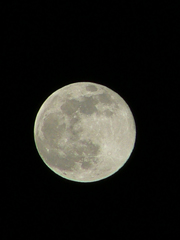 Resumed drilling in Hole C0010D from 06:45 h, after WOW and DPS “Yellow” status returned to “Green”. Reached 385 mbsf at 19:15 h and began coring. After core was recovered, downhole conditions rapidly worsened. The decision was made to abandon Hole C0010D and spud in at a new location.
Resumed drilling in Hole C0010D from 06:45 h, after WOW and DPS “Yellow” status returned to “Green”. Reached 385 mbsf at 19:15 h and began coring. After core was recovered, downhole conditions rapidly worsened. The decision was made to abandon Hole C0010D and spud in at a new location.Scientists working on completing Hole C0010C results. A science meeting to check the status of results was held in the evening. Figures for the entire volume were reviewed and consolidated.
Photo of the Day:
Full moon, as seen from Chikyu’s core cutting area.

4.21, 2016
Day:26
Location:Hole C0010D.
Weather:Rain
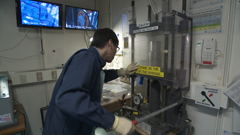 Spud in at Hole C0010D at 06:45 h, began jetting in to 34 mbsf, then drilling ahead to 380 mbsf. Drilling ahead slowed with the approach of a cold front, that coring could begin once the front passed. Chikyu DPS reached “Yellow” condition – well offset greater than 15 m, so the drill string was pulled up to cs. 31 mbsf to wait on weather (WOW).
Spud in at Hole C0010D at 06:45 h, began jetting in to 34 mbsf, then drilling ahead to 380 mbsf. Drilling ahead slowed with the approach of a cold front, that coring could begin once the front passed. Chikyu DPS reached “Yellow” condition – well offset greater than 15 m, so the drill string was pulled up to cs. 31 mbsf to wait on weather (WOW).Scientists working on completing Hole C0010C results. A science meeting to check the status of results was held in the evening.
Photo of the Day:
MWJ Lab Technician squeezing an IW whole round sample in the press to recover interstitial water for geochemical analysis.

4.20, 2016
Day:25
Location:Hole C0010C.
Weather:Clear
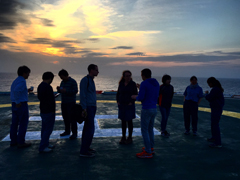 Coring at Hole C0010C from 300 mbsf began, with 6 cores collected by 24:00 h. Recovery is variable, but good (average: >70%). Hole conditions are a bit difficult, but coring continues.
Coring at Hole C0010C from 300 mbsf began, with 6 cores collected by 24:00 h. Recovery is variable, but good (average: >70%). Hole conditions are a bit difficult, but coring continues.Core condition continues to improve with depth. A quick science meeting to bring both shifts up to speed on coring and operation plans was held. As of midnight, we have cored a total of 95 meters, with 52.6 m recovered (55.4%).
Photo of the Day:
The scientists taking a moment to enjoy watching the sun set from the helideck.

4.19, 2016
Day:24
Location:Hole C0010C.
Weather:Partly cloudy
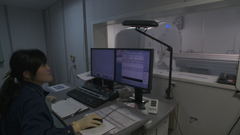 After drilling ahead at Hole C0010C to 300 mbsf, coring began. 6 cores were collected by 24:00 h. Recovery is variable, but generally good (>40%).
After drilling ahead at Hole C0010C to 300 mbsf, coring began. 6 cores were collected by 24:00 h. Recovery is variable, but generally good (>40%).The science party had their first experience with core, and the watchdogs for the XCT whole round scanning began. Although core recovery is generally good, there are few large intact whole round intervals. Core condition seem to be improving with depth. Writing for the methods chapter is largely complete, and results writing are proceeding apace. The MWJ publications specialists boarded today, so they are working to ensure all loose ends are being tied up.
Photo of the Day:
MWJ Lab Technician preparing the XCT scanner for the first core sections from Hole C0010C.

4.18, 2016
Day:23
Location:Hole C0010C.
Weather:Overcast
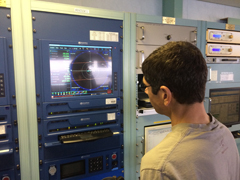 After getting first core from Hole C0010B, which returned an empty core liner amid worsening hole conditions, the co-Chief scientist, EPM, and OSI decided to abandon Hole C0010B and spud into a new hole. Spud-in at Hole C0010C commenced, then washed down 34 mbsf before beginning to drill ahead to running down to 300 mbsf.
After getting first core from Hole C0010B, which returned an empty core liner amid worsening hole conditions, the co-Chief scientist, EPM, and OSI decided to abandon Hole C0010B and spud into a new hole. Spud-in at Hole C0010C commenced, then washed down 34 mbsf before beginning to drill ahead to running down to 300 mbsf.The science party had their first dry run in the core cutting area, and prepared for cores from Hole C0010C. Science reports have completed methods, and are in the process of completing the C0010A methods.
Photo of the Day:
Co-Chief on the bridge after the spud-in position for Hole C0010C was confirmed.

4.17, 2016
Day:22
Location:Hole C0010B.
Weather:Partly cloudy
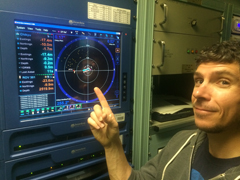 Tagged the sea floor and started jetting down to establish Hole C0010B. The approach of bad weather caused a wait-on-weather (WOW) period when the BHA was brought up to ca. 30 mbsf while waiting for the weather to pass. Once conditions improved, running down to ~100 mbsf resumed.
Tagged the sea floor and started jetting down to establish Hole C0010B. The approach of bad weather caused a wait-on-weather (WOW) period when the BHA was brought up to ca. 30 mbsf while waiting for the weather to pass. Once conditions improved, running down to ~100 mbsf resumed.The science party prepared for coring operations, and decided on shifts and XCT watch dogs.
Photo of the Day:
Co-Chief on the bridge after the spud-in position for Hole C0010B was confirmed.

4.16, 2016
Day:21
Location:2.9 nmi NW of Hole C0010A.
Weather:Clear
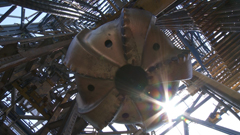 Rigged down the LTBMS running equipment. Rigged up the guide horn in the moon pool and then making up the 10-5/8-inch RCB coring BHA.
Rigged down the LTBMS running equipment. Rigged up the guide horn in the moon pool and then making up the 10-5/8-inch RCB coring BHA.The science reports are in final editing for most of the methods, and results drafts are in review for the LTBMS and GeniusPlug data and samples. Sample request revisions were reviewed and discussed. The science party is prepared for the shift in tempo once coring operations being.
Photo of the Day:
Looking up the 10-5/8-inch bit and derrick after making up the coring BHA on the rig floor.

4.15, 2016
Day:20
Location:2.9 nmi NW of Hole C0010A.
Weather:Partly cloudy
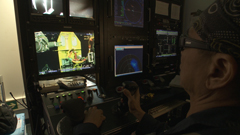 The LTBMS head landed safely on the wellhead at 05:20 h this morning, followed by sensor tests, cementing, and finally releasing the running tool and POOH running BHA. The new moon pool facilities, the guide roller and completion guide roller equipment designed by CDEX OSI have drastically improved the safety and efficiency of running delicate scientific sensors in the Kuroshio current. These new tools have made the quick and easy deployment of the LTBMS and recovery of the GeniusPlug possible. The co-Chiefs and EPM are especially impressed, given their previous experience working similar operations at Site C0010 during IODP Expeditions 319, 326, and 332.
The LTBMS head landed safely on the wellhead at 05:20 h this morning, followed by sensor tests, cementing, and finally releasing the running tool and POOH running BHA. The new moon pool facilities, the guide roller and completion guide roller equipment designed by CDEX OSI have drastically improved the safety and efficiency of running delicate scientific sensors in the Kuroshio current. These new tools have made the quick and easy deployment of the LTBMS and recovery of the GeniusPlug possible. The co-Chiefs and EPM are especially impressed, given their previous experience working similar operations at Site C0010 during IODP Expeditions 319, 326, and 332.The scientists worked on testing the LTBMS downhole sensors and the LTBMS CORK head PSU unit. All sensors were left in working order at the end of deployment. Contingency science targets will now include coring operations at Site C0010. Scientists worked on setting coring targets and lab orientation for limited core analysis and sampling. Whole round cores will be left for s future shore-based sample party.
Photo of the Day:
The Oceaneering ROV team plugging the underwater mateable connector (UMC) cable into the LTBMS pressure sensor unit (PSU) so the scientists can perform a health check of the pressure sensors.

4.14, 2016
Day:20
Location:Hole C0010A.
Weather:Overcast
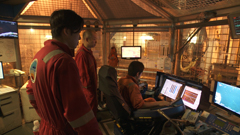 The LTBMS and Chikyu drifted back to Hole C0010A at 0.6 kt. The LTBMS slowly re-entered the well late in the evening. Running into the wellhead continued all night.
The LTBMS and Chikyu drifted back to Hole C0010A at 0.6 kt. The LTBMS slowly re-entered the well late in the evening. Running into the wellhead continued all night.The scientists continued to work on their reports; a science meeting to review progress was followed by a lab tour led by MWJ Lab Officer, who guided the scientists along a typical core flow. Various instruments typically used for whole round core analyses were introduced. The Test rigs for the LTBMS were rigged down and removed from the moon pool area into the core processing lab.
Photo of the Day:
OSI and Drilling Engineer watching from the driller’s house as the LTBMS CORK head is lowered on the wellhead.

4.13, 2016
Day:19
Location:5.7 nmi NW of Site C0010.
Weather:Overcast
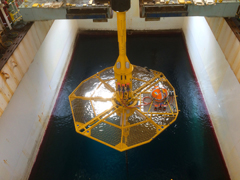 The ROV platform was made up and attached to the LTBMS cork head after which the temporary data recorder packages was attached to the platform and then connected to the sensor cables. The LTBMS was run into the water and run down to 1300 mBRT before attaching VIV-suppression ropes in preparation for drifting.
The ROV platform was made up and attached to the LTBMS cork head after which the temporary data recorder packages was attached to the platform and then connected to the sensor cables. The LTBMS was run into the water and run down to 1300 mBRT before attaching VIV-suppression ropes in preparation for drifting.CDEX Science Director stayed overnight on Chikyu to meet with the science party and get briefed on the expedition progress and future schedule. He returned on the first heli to shore. Sensor communication tests before and after running the LTBMS into the moon pool confirmed that all sensors were operating as expected.
Photo of the Day:
LTBMS being run into the moon pool after assembly completed.

4.12, 2016
Day:18
Location:13.9 nmi NW of Site C0010.
Weather:Overcast
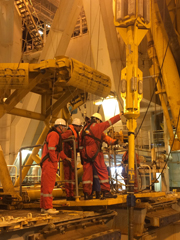 ODI prepared and cured the underwater connections for the LTBMS data and power cables.
ODI prepared and cured the underwater connections for the LTBMS data and power cables.One of the co-chief rotated off Chikyu today, leaving the other sole co-Chief aboard. We were able to have crossover meetings with both co-Chief scientists and CDEX, discussing operational progress and review of the current operational schedule. The scientists held a small science meeting to catch up on expedition reports and parallel research related to the 1 April 2016 earthquake.
Photo of the Day:
Co-Chiefs checking the pressure sensor flatpack configuration early in the morning above the moon pool.

4.11, 2016
Day:17
Location:21.1 nmi NW of Site C0010.
Weather:Partly cloudy
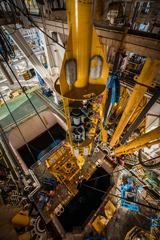 The deck crew moved the LTBMS to the middle pipe rack for final preparations before deployment. The final grounding to prevent corrosion to the seafloor pressure sensor on the pressure sensor unit (PSU) after deployment was completed by early afternoon. The LTBMS was made up and then run into the rig floor and down to the moon pool.
The deck crew moved the LTBMS to the middle pipe rack for final preparations before deployment. The final grounding to prevent corrosion to the seafloor pressure sensor on the pressure sensor unit (PSU) after deployment was completed by early afternoon. The LTBMS was made up and then run into the rig floor and down to the moon pool. The scientists worked on finalizing the PSU for deployment on the LTBMS head. The sensor carrier and strainmeter sensor were periodically checked to confirm that they were still functioning correctly. Report writing and editing continued.
Photo of the Day:
The LTBMS seen above the moon pool after making up and being lowered through the rig floor.

4.10, 2016
Day:16
Location:24 nmi NW of Site C0010.
Weather:Overcast
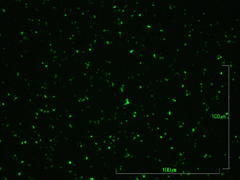 CMG broadband seismometer and strainmeter return signal troubleshooting revealed that the issue was within the test rig; once this was isolated and confirmed, the sensors and LTBMS were made up again and re-run into the hole. The completion running reached the swellable packer, and paused for sensor function tests.
CMG broadband seismometer and strainmeter return signal troubleshooting revealed that the issue was within the test rig; once this was isolated and confirmed, the sensors and LTBMS were made up again and re-run into the hole. The completion running reached the swellable packer, and paused for sensor function tests. The functions testing for the PSU unit continues, while troubleshooting the PSU data recorder continues. The scientists are working on completing the methods sections for the expedition report.
Photo of the Day:
Microphotograph of the successful barite culture experiment showing SYBR GRGreen 1 stained microbes seen through a FTIC filter.

4.9, 2016
Day:15
Location:24.3 nmi NW of Site C0010.
Weather:Overcast
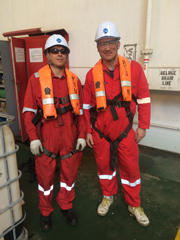 h
The LTBMS completion assembly pulled from the hole to lay down the sensor carrier and the strainmeter so they could be re-tested and replaced, as needed, with back-up sensors.
h
The LTBMS completion assembly pulled from the hole to lay down the sensor carrier and the strainmeter so they could be re-tested and replaced, as needed, with back-up sensors. The functions testing for the PSU unit continues, and is partially completed. The FLOCS microbial culture experiment returned some positive results, showing growth on the culture medium. Analysis of the FLOCS/Osmosampler chemistry continues. The co-Chiefs reviewed the sample requests and the shipboard Sample Allocation Committee submitted their final approval to the Chikyu curator for the current requests.
Photo of the Day:
Co-chiefs dressed in appropriate PPE at the moon pool to oversee flatpack mating to the pressure sensor miniscreens.

4.8, 2016
Day:14
Location:24.3 nmi NW of Site C0010.
Weather:Partly cloudy
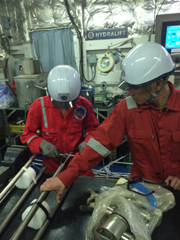 Once the cold front passed, the weather improved, so loading from the supply boat began. The LTBMS sensors and sensor carrier were moved from the core tech workshop to the middle pipe rack in preparation for assembly and running in the hole (RIH). The LTBMS completion assembly was picked up and begun to be RIH from 15:00 h.
Once the cold front passed, the weather improved, so loading from the supply boat began. The LTBMS sensors and sensor carrier were moved from the core tech workshop to the middle pipe rack in preparation for assembly and running in the hole (RIH). The LTBMS completion assembly was picked up and begun to be RIH from 15:00 h.The functions testing for the PSU unit continues, and will be continued for the next 24 hours. The scientists gathered to discuss post cruise research plans, and a summary was passed around to the shipboard and shore-based scientists for review and revision.
Photo of the Day:
Co-chief and CDEX Engineer finishing a check of the Swagelok fittings for the #1 pressure sensor miniscreens.

4.7, 2016
Day:13
Location:33 nmi NW of Site C0010.
Weather:Cloudy
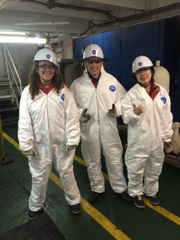 Preparations for running the LTBMS completion continued until 07:30 h. At that time, D/V Chikyu moved to avoid the effects of the cold front passing over the drill site, and all work was stopped on deck.
Preparations for running the LTBMS completion continued until 07:30 h. At that time, D/V Chikyu moved to avoid the effects of the cold front passing over the drill site, and all work was stopped on deck.Pressure testing on the primary PSU on the aft pipe rack began in the morning, revealing some leaks in the hydraulic valves. Science party discussed post-cruise research targets. Some ideas for papers tangentially related to the expedition, but relying mainly on the Hole C0002G LTBMS were also discussed.
Photo of the Day:
Scientists in tyvek suits ready to head out to the rear pipe rack to begin function testing the LTBMS PSU.

4.6, 2016
Day:12
Location:3.2 nmi SE of Site C0010.
Weather:Partly cloudy
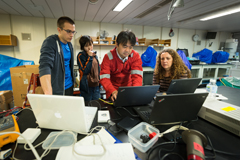 The guide horn was rigged down in preparation for running the LTBMS installation. The scientists worked on moving the LTBMS sensors and data recorder to the core tech workshop and began attaching them to the sensor carrier. The PSU was moved to the aft pipe rack to begin pressure testing on the primary and secondary cork heads.
The guide horn was rigged down in preparation for running the LTBMS installation. The scientists worked on moving the LTBMS sensors and data recorder to the core tech workshop and began attaching them to the sensor carrier. The PSU was moved to the aft pipe rack to begin pressure testing on the primary and secondary cork heads.There was a brief meeting to review methods writing assignments in afternoon. Osmosampler specialist updated the co-Chiefs in the evening about the chemistry results from the ICP-AES.
Photo of the Day:
Scientists working on the pressure sensor unit (PSU).

4.5, 2016
Day:11
Location:Hole C0010A.
Weather:Partly cloudy
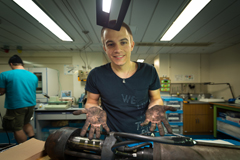 After completing reaming the hole to 9-7/8-inch, the BHA was POOH and laid down in preparation for the casing scraper. Another Co-Chief Scientist arrived on board in the morning via helicopter transfer. The scientists held a general meeting to bring the new co-Chief up to date on their activities, and the review ended with an outline for future research collaboration.
After completing reaming the hole to 9-7/8-inch, the BHA was POOH and laid down in preparation for the casing scraper. Another Co-Chief Scientist arrived on board in the morning via helicopter transfer. The scientists held a general meeting to bring the new co-Chief up to date on their activities, and the review ended with an outline for future research collaboration.The new O-rings were fitted to the pressure chamber of the LTBMS pressure sensor unit (PSU), which was configured for deployment and a 12-hour test run. The GeniusPlug pressure data was finally successfully converted for an initial review, and the 1 April (“April Fool’s”) quake signal was clearly seen. Further analysis is underway. The initial chemistry analysis results from the FLOCS & Osmosampler were received, and science discussions regarding the chemistry continues.
Photo of the Day:
Scientist shows the results of struggling to remove the inner structure of the GeniusPlug.

4.4, 2016
Day:10
Location:Hole C0010A.
Weather:Partly cloudy
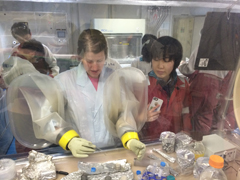 The drilling/underreaming BHA was made up and run in the rig floor in the early morning. By 21:30h, drilling had reached 654 mbsf. Laboratory analysis of samples is ongoing. The science party continued working on the GeniusPlug data and the laboratory analysis of the Osmosampler/FLOCS samples. The science party are also looking at C0002G LTBMS data and DONET seafloor data to analyze the 1 April earthquake. The C0010A sensors are beginning to be hooked up in preparation for the observatory deployment.
The drilling/underreaming BHA was made up and run in the rig floor in the early morning. By 21:30h, drilling had reached 654 mbsf. Laboratory analysis of samples is ongoing. The science party continued working on the GeniusPlug data and the laboratory analysis of the Osmosampler/FLOCS samples. The science party are also looking at C0002G LTBMS data and DONET seafloor data to analyze the 1 April earthquake. The C0010A sensors are beginning to be hooked up in preparation for the observatory deployment.
Photo of the Day:
Scientists working on samples extracted from the GeniusPlug Osmosampler/FLOCS experiment.

4.3, 2016
Day:9
Location:In low current area 8 nmi from Site C0010.
Weather:Rain
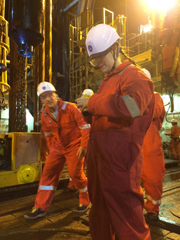 After recovering the L10 On/Off tool and the A-3 bridgeplug, the GeniusPlug was laid down on the rigfloor at 04:50 h. The Osmosampler chamber of the GeniusPlug was opened and the Osmosampler/FLOCS experiment and moved to the microbiology laboratory for decanting. The pressure sensors and remainder of the GeniusPlug, in the meantime, were stored on the rig floor. The GeniusPlug pressure sensors were moved into the lab in the afternoon and the pressure housing was opened and data download began from 20:20 h and was completed at 23:30 h. Work on the data continues.
After recovering the L10 On/Off tool and the A-3 bridgeplug, the GeniusPlug was laid down on the rigfloor at 04:50 h. The Osmosampler chamber of the GeniusPlug was opened and the Osmosampler/FLOCS experiment and moved to the microbiology laboratory for decanting. The pressure sensors and remainder of the GeniusPlug, in the meantime, were stored on the rig floor. The GeniusPlug pressure sensors were moved into the lab in the afternoon and the pressure housing was opened and data download began from 20:20 h and was completed at 23:30 h. Work on the data continues.
Photo of the Day:
Scientist is on the rig floor, plugging the inlet tubing for the GeniusPlug OsmoSampler/FLOCS experiment as co-Chief steps in to observe.

4.2, 2016
Day:8
Location:In low current area 13.5 nmi from Site C0010
Weather:Cloudy
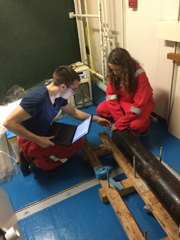 Drifting to the LCA to remove the remaining VIV-suppression ropes, and raise the BHA from 1800 mBRT to rig floor. The general safety meeting was held by CHSEO Dennis Noordjik in the afternoon on the upper deck. The accelerometer was recovered from the drill string at 2320 h.
Drifting to the LCA to remove the remaining VIV-suppression ropes, and raise the BHA from 1800 mBRT to rig floor. The general safety meeting was held by CHSEO Dennis Noordjik in the afternoon on the upper deck. The accelerometer was recovered from the drill string at 2320 h.
Photo of the Day:
Scientists examining GeniusPlug back up on Core Processing Deck.

4.1, 2016
Day:7
Location:Site C0010
Weather:Overcast
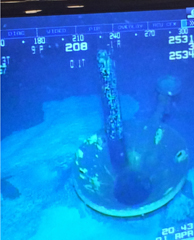 While standing by Hole C0010A and preparing to stab in, a M6.0 quake struck at 11:36 h (JST). The epicenter is reported as being ca. 10 nmi to the NW of Site C0010, and 15 km deep. The quake was felt aboard ship. Science discussions examined preliminary analysis of data from the DONET undersea network and the Hole C0002G LTBMS sensors. The GeniusPlug was recovered from the
wellhead at 20:45 h.
While standing by Hole C0010A and preparing to stab in, a M6.0 quake struck at 11:36 h (JST). The epicenter is reported as being ca. 10 nmi to the NW of Site C0010, and 15 km deep. The quake was felt aboard ship. Science discussions examined preliminary analysis of data from the DONET undersea network and the Hole C0002G LTBMS sensors. The GeniusPlug was recovered from the
wellhead at 20:45 h.
Photo of the Day:
The GeniusPlug observatory clears the Hole C0010A wellhead (20:40 h).


3.31, 2016
Day:6
Location: 1.9 nmi NW of Site C0010
Weather: Overcast
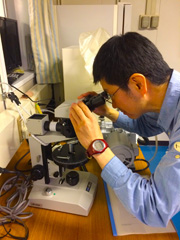 Drifting to Site C0010. The scientists attached an accelerometer to the GeniusPlug recovery tool before running in hole (RIH). Lab safety review and walkthrough performed with MWJ Lab Officer.
Drifting to Site C0010. The scientists attached an accelerometer to the GeniusPlug recovery tool before running in hole (RIH). Lab safety review and walkthrough performed with MWJ Lab Officer.The L10 On/Off tool Bore Hole Assembly (BHA) was run while attaching anti-Vortex Induced Vibration (VIV) ropes. Once the LCA was reached, drifting to Site C0010 began.
Photo of the Day:
MWJ Lab Officer examining thin section lab optical microscope during monthly laboratory safety review.

3.30, 2016
Day:5
Location: In the low current area (LCA) 12 nmi NNW of Site C0010
Weather: Partly cloudy
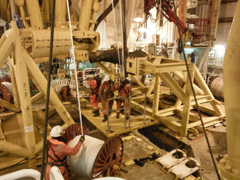 After arriving at Site C0010 at 03:30 h, the ROV dove and set transponders, surveyed the seabed, and removed the corrosion cap. The scientists gathered for a science discussion.
After arriving at Site C0010 at 03:30 h, the ROV dove and set transponders, surveyed the seabed, and removed the corrosion cap. The scientists gathered for a science discussion.Reached Site C0010, dove ROV, surveyed seabed, placed transponders, calibrated the DPS, and removed corrosion cap. The ROV was recovered for needed umbilical repairs. The vessel moved 12 nmi NW from well center. The A-3 packer retrieval tool was run into the hole (RIH).
Photo of the Day:
Rig crew in the moon pool on the new anti-VIV running tools on the BOP cart. This new configuration increases safety and efficiency in attaching and removing the anti-VIV ropes to the drill string.

3.29, 2016
Day:4
Location: In transit to Site C0010
Weather: Clear
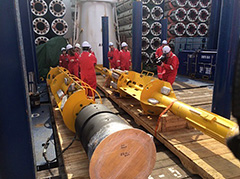 The ship left Shimizu harbor and proceeded to Site C0010. The scientists were given a short introduction of the LTBMS sensors being calibrated in the Core Processing Lab, and in the Core Tech Workshop. A short tour of the Moonpool, BOP, and riser racks followed. The LTBMS wellheads (2 sets) were examined on the aft pipe racks, and LTBMS lead scientist explained the layout and running mechanism. The evening ended with SciencemediaNL videographers showing the science party and Marine Works Japan Lab Techs some examples of previous IODP films produced by SciencemediaNL.
The ship left Shimizu harbor and proceeded to Site C0010. The scientists were given a short introduction of the LTBMS sensors being calibrated in the Core Processing Lab, and in the Core Tech Workshop. A short tour of the Moonpool, BOP, and riser racks followed. The LTBMS wellheads (2 sets) were examined on the aft pipe racks, and LTBMS lead scientist explained the layout and running mechanism. The evening ended with SciencemediaNL videographers showing the science party and Marine Works Japan Lab Techs some examples of previous IODP films produced by SciencemediaNL.Photo of the Day:
Scientists getting a quick overview of the new LTBMS CORK heads on the aft pipe rack aboard DV Chikyu. Two complete sets, including ROV platforms, are onboard.

3.26-28, 2016
Day:1-3
Location: Shimizu harbor
Weather: Clear
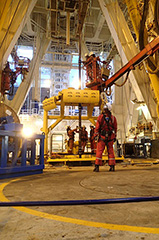 Stand-by and loading/offloading in Shimizu harbor. The Science Party members arrived and boarded DV Chikyu on 26-27 March 2016 and began lab and moonpool preparations for running the Long Term Borehole Monitoring System (LTBMS). LTBMS sensors were calibrated and checked, and the microbiology lab was prepared for the recovery of samples from the currently deployed GeniusPlug at Site C0010. On 28 March, a pre-spud meeting was held onboard, with the Mantle Quest Japan (MQJ) Captain, Offshore Installation Manager (OIM) and crew, CDEX senior staff, and the science party in attendance. The scientific background, operations plans, and safety issues were presented and discussed. The IODP Exp 365 Videographers from SciencemediaNL attended and presented a short video on IODP (https://www.youtube.com/watch?v=yZvm15Gg4wo) to the attendees as an example of past IODP-related work.
Stand-by and loading/offloading in Shimizu harbor. The Science Party members arrived and boarded DV Chikyu on 26-27 March 2016 and began lab and moonpool preparations for running the Long Term Borehole Monitoring System (LTBMS). LTBMS sensors were calibrated and checked, and the microbiology lab was prepared for the recovery of samples from the currently deployed GeniusPlug at Site C0010. On 28 March, a pre-spud meeting was held onboard, with the Mantle Quest Japan (MQJ) Captain, Offshore Installation Manager (OIM) and crew, CDEX senior staff, and the science party in attendance. The scientific background, operations plans, and safety issues were presented and discussed. The IODP Exp 365 Videographers from SciencemediaNL attended and presented a short video on IODP (https://www.youtube.com/watch?v=yZvm15Gg4wo) to the attendees as an example of past IODP-related work.Photo of the Day:
MQJ and scientists testing the new guide roller for the LTBMS deployment in the moonpool.


















